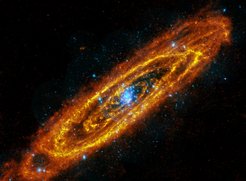Andromeda in a different light

Copyright: ESA/Herschel/ PACS/SPIRE/J.Fritz(U.Gent) / XMM-Newton/EPIC/W.Pietsch(MPE)
Andromeda
Copyright: ESA/Herschel/ PACS/SPIRE/J.Fritz(U.Gent) / XMM-Newton/EPIC/W.Pietsch(MPE)
The big, beautiful Andromeda Galaxy, aka M31, is a spiral galaxy a mere 2.5 million light-years away. Two space-based observatories have combined to produce this intriguing composite image of Andromeda, at wavelengths outside the visible spectrum, which was selected as
![]() Astronomy Picture of the Day (APOD) by NASA. The remarkable view follows the locations of this galaxy's once and future stars. In reddish hues, image data from the large Herschel infrared observatory traces enormous lanes of dust, warmed by stars, sweeping along Andromeda's spiral arms. The dust, in conjunction with the galaxy's interstellar gas, comprises the raw material for future star formation. X-ray data from the XMM-Newton observatory in blue pinpoint Andromeda's X-ray binary star systems. These systems likely contain neutron stars or stellar mass black holes that represent final stages in stellar evolution. More than twice the size of our own Milky Way, the Andromeda Galaxy is over 200,000 light-years across.
Astronomy Picture of the Day (APOD) by NASA. The remarkable view follows the locations of this galaxy's once and future stars. In reddish hues, image data from the large Herschel infrared observatory traces enormous lanes of dust, warmed by stars, sweeping along Andromeda's spiral arms. The dust, in conjunction with the galaxy's interstellar gas, comprises the raw material for future star formation. X-ray data from the XMM-Newton observatory in blue pinpoint Andromeda's X-ray binary star systems. These systems likely contain neutron stars or stellar mass black holes that represent final stages in stellar evolution. More than twice the size of our own Milky Way, the Andromeda Galaxy is over 200,000 light-years across.
The Herschel space observatory was launched in May 2009 and produces impressive images of the sky in infrared wavelengths. Max Planck Institutes played a crucial role in creating two of the three instruments: The PACS instrument was designed and built by the Max Planck Institute for Extraterrestrial Physics (MPE) in Garching in cooperation with the Max Planck Institute for Astronomy (MPIA) in Heidelberg and other partners from six European countries. PACS (Photodetector Array Camera and Spectrometer) will carry out imaging photometry and spectroscopy with a never before achieved accuracy and sensitivity in the far infrared, between 57 and 210 micrometres.












